#aditya l1 launch place
Text
Aditya L1 Mission Launch शुरू: कब और कहाँ देखें, लॉन्च की तारीख और समय
Aditya L1 Mission Launch: आदित्य एल1 लॉन्च, इसरो लैग्रेन्जियन प्वाइंट 1 से सूर्य का अध्ययन करने के लिए 2 सितंबर को आदित्य-एल1 सौर मिशन लॉन्च करेगा।
आदित्य एल1 लॉन्च: चंद्रयान-3 ( Chandrayaan 3 ) की सफल सॉफ्ट लैंडिंग के बाद अब इसरो देश का पहला सौर मिशन Aditya L1 लॉन्च करने की तैयारी में है। आदित्य-एल1 अंतरिक्ष यान को सौर कोरोना के दूरस्थ अवलोकन और एल1 (सूर्य-पृथ्वी लैग्रेंजियन बिंदु) पर सौर हवा…
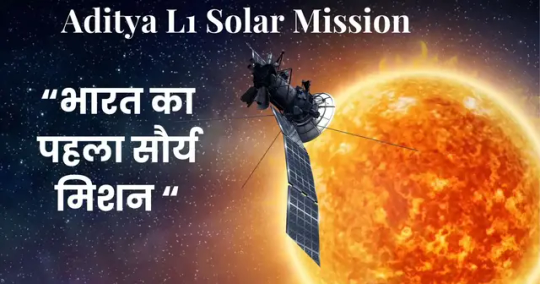
View On WordPress
#aditya l1 budget#aditya l1 launch date 2023#aditya l1 launch date and landing date#aditya l1 launch landing date#aditya l1 launch live#aditya l1 launch place#aditya l1 mission launch date 2023#when will aditya l1 launch date and time
0 notes
Text
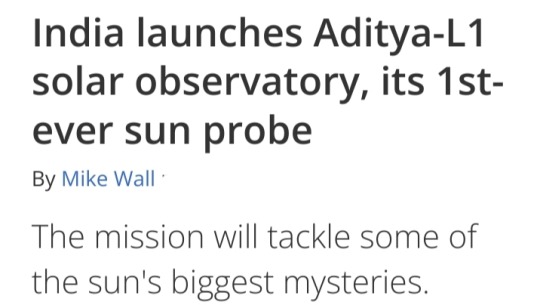
2 September 2022
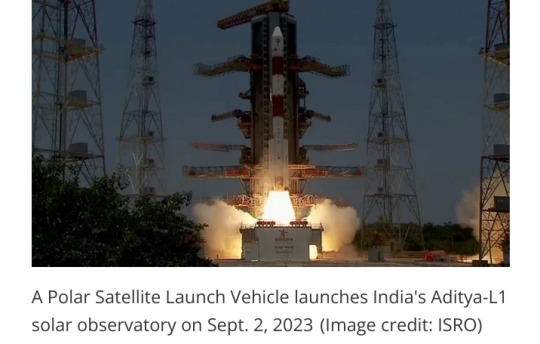
Fresh off its success at the moon, India is now headed for the sun.
The nation launched its first-ever solar observatory today (Sept. 2), sending the Aditya-L1 probe skyward atop a Polar Satellite Launch Vehicle (PSLV) from Satish Dhawan Space Centre at 2:20 a.m. EDT (0620 GMT; 11:50 a.m. local India time).
The PSLV deployed Aditya-L1 into low Earth orbit (LEO) as planned about 63 minutes after liftoff, sparking applause and high fives in mission control.
"Congratulations, India, and congratulations, ISRO [the Indian Space Research Organisation]," Jitendra Singh, India's Minister of State for Science and Technology, said shortly after deployment on ISRO's launch webcast.
"While the whole world watched this with bated breath, it is indeed a sunshine moment for India," Singh added.
The successful launch followed on the heels of another big milestone for India: On August 23, its Chandrayaan-3 mission became the first to land softly near the moon's south pole.
Chandrayaan-3's lander-rover duo are expected to conk out in a week or so, when the harsh lunar night falls at their touchdown site. But Aditya-L1's long journey has just begun.
A long road to a good sun-viewing spot
Aditya-L1 won't stay in LEO forever:
After a series of checkouts, it will use its onboard propulsion system to head toward Earth-sun Lagrange Point 1 (L1), a gravitationally stable spot about 1 million miles (1.5 million kilometers) from our planet in the direction of the sun.
That destination explains the latter part of the mission's name. And the first part is simple enough: "Aditya" translates to "sun" in Sanskrit.
The 3,260-pound (1,480 kilograms) observatory will arrive at L1 about four months from now, if all goes according to plan.
But the long trek will be worth it, according to the ISRO.
"A satellite placed in the halo orbit around the L1 point has the major advantage of continuously viewing the sun without any occultation/eclipses," ISRO officials wrote in an Aditya-L1 mission description.
"This will provide a greater advantage of observing the solar activities and its effect on space weather in real time."
Indeed, another sun-studying spacecraft is already at L1 — the Solar and Heliospheric Observatory (SOHO), a joint NASA-European Space Agency mission that launched in December 1995.
(Several other spacecraft, including NASA's James Webb Space Telescope, are at Earth-sun Lagrange Point 2, which is a million miles from Earth, in the direction away from the sun.)

Solar flares, the coronal heating mystery and more
Once it's settled in at L1, the solar probe will use four three science instruments to study the particles and magnetic fields in its immediate surroundings and four others to scrutinize the sun's surface (known as the photosphere) and its atmosphere.
This work will help scientists better understand solar activity, including the dynamics of solar flares and coronal mass ejections (CMEs), ISRO officials say.
Flares are powerful flashes of high-energy radiation, and CMEs are huge eruptions of solar plasma.
Both types of outburst can affect us here on Earth. Intense CMEs that hit our planet, for example, trigger geomagnetic storms that can disrupt satellite navigation and power grids.
(As a side benefit, such storms also supercharge the gorgeous light shows known as auroras.)
Aditya-L1 will also tackle the "coronal heating problem," one of the biggest mysteries in heliophysics.
The corona — the sun's wispy outer atmosphere — is incredibly hot, reaching temperatures around 2 million degrees Fahrenheit (1.1 million degrees Celsius), according to NASA.
That's about 200 times hotter than the solar surface, which is "only" 10,000 degrees F (5,500 degrees C) or so.
It's still unclear what is responsible for this startling and counterintuitive discrepancy.
(Why would it be hotter away from the sun's core, where the energy-producing nuclear fusion reactions are occurring?)
Aditya-L1 has other science goals as well. For instance, the mission also aims to more fully flesh out the solar wind, the stream of charged particles flowing constantly from the sun, ISRO officials said.
Aditya-L1 will measure the composition of the solar wind and attempt to determine how it is accelerated.
And Aditya-L1 will do all this work on the cheap:
The mission's price tag is about 3.8 billion rupees, or $46 million US at current exchange rates.
That's in the same ballpark as Chandrayaan-3
India's first successful moon-landing mission costs about 6.15 billion rupees, or $74 million US.
For comparison, NASA's most recent big-ticket sun mission, the record-setting Parker Solar Probe, costs roughly $1.5 billion.
This disparity should not be viewed as an indictment of NASA, however; labor costs are much higher in the United States than in India, among other differences between the two nations' economies.
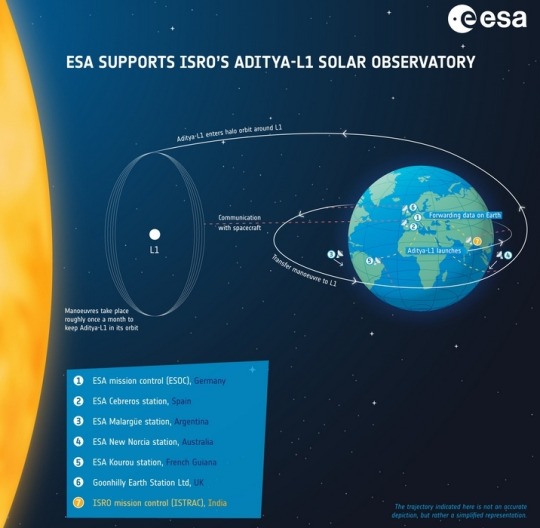
Aditya-L1 is a coronagraphy spacecraft to study the solar atmosphere, designed and developed by the Indian Space Research Organisation (ISRO) and various other Indian research institutes.
#India#Aditya-L1#Polar Satellite Launch Vehicle (PSLV)#Satish Dhawan Space Centre#low Earth orbit (LEO)#sun#Indian Space Research Organisation#Chandrayaan-3#Earth-sun Lagrange Point 1 (L1)#Solar and Heliospheric Observatory (SOHO)#solar flares#coronal mass ejections (CMEs)#coronal heating problem#heliophysics#solar wind#Parker Solar Probe#NASA#solar observatory#solar atmosphere
13 notes
·
View notes
Text
this is somehow a beautiful headline
named Aditya, one of the Sanskrit names for the sun
5 notes
·
View notes
Text
Aditya-L1: India’s First Mission to Study the Sun
Aditya-L1 is India's pioneering space mission dedicated to solar observation, aiming to enhance our understanding of the Sun's dynamics and its influence on the Earth's climate. Launched by the Indian Space Research Organisation (ISRO), this mission will study various solar phenomena, including solar flares, coronal mass ejections, and the solar wind. By placing a satellite at the Lagrange Point 1 (L1) between the Earth and the Sun, aditya l1 will provide continuous real-time data, contributing to advancements in solar physics and space weather forecasting. This mission marks a significant step in India's space exploration efforts, showcasing its commitment to scientific research and innovation.
0 notes
Text
Events 9.2 (after 1940)
1944 – The last execution of a Finn in Finland takes place when soldier Olavi Laiho is executed by shooting in Oulu.
1945 – World War II: The Japanese Instrument of Surrender is signed by Japan and the major warring powers aboard the battleship USS Missouri in Tokyo Bay.
1945 – Communist leader Ho Chi Minh proclaimed the Democratic Republic of Vietnam after the end of the Nguyễn dynasty.
1946 – The Interim Government of India is formed, headed by Jawaharlal Nehru as vice president with the powers of a Prime Minister.
1957 – President Ngô Đình Diệm of South Vietnam becomes the first foreign head of state to make a state visit to Australia.
1958 – A USAF RC-130 is shot down by fighters over Armenia when it strays into Soviet airspace while conducting a sigint mission. All crew members are killed.
1960 – The first election of the Tibetan Parliament-in-Exile. The Tibetan community observes this date as Democracy Day.
1963 – CBS Evening News becomes U.S. network television's first half-hour weeknight news broadcast, when the show is lengthened from 15 to 30 minutes.
1968 – Operation OAU begins during the Nigerian Civil War.
1970 – NASA announces the cancellation of two Apollo missions to the Moon, Apollo 15 (the designation is re-used by a later mission), and Apollo 19.
1984 – Seven people are shot and killed and 12 wounded in the Milperra massacre, a shootout between the rival motorcycle gangs Bandidos and Comancheros in Sydney, Australia.
1985 – Sri Lankan Civil War: Sri Lankan Tamil politicians and former MPs M. Alalasundaram and V. Dharmalingam are shot dead.
1987 – In Moscow, the trial begins for 19-year-old pilot Mathias Rust, who flew his Cessna airplane into Red Square in May.
1990 – Transnistria is unilaterally proclaimed a Soviet republic; the Soviet president Mikhail Gorbachev declares the decision null and void.
1992 – The 7.7 Mw Nicaragua earthquake affected the west coast of Nicaragua. With a Ms–Mw disparity of half a unit, this tsunami earthquake triggered a tsunami that caused most of the damage and casualties, with at least 116 killed. Typical runup heights were 3–8 meters (9.8–26.2 ft).
1998 – Swissair Flight 111 crashes near Peggy's Cove, Nova Scotia; all 229 people on board are killed.
1998 – The UN's International Criminal Tribunal for Rwanda finds Jean-Paul Akayesu, the former mayor of a small town in Rwanda, guilty of nine counts of genocide.
2008 – Google launches its Google Chrome web browser.
2009 – The Andhra Pradesh, India helicopter crash occurred near Rudrakonda Hill, 40 nautical miles (74 km) from Kurnool, Andhra Pradesh, India. Fatalities included Y. S. Rajasekhara Reddy, the Chief Minister of the Indian state of Andhra Pradesh.
2010 – Israel-Palestinian conflict: the 2010 Israeli-Palestinian peace talks are launched by the United States.
2013 – The Eastern span replacement of the San Francisco–Oakland Bay Bridge opens at 10:15 PM at a cost of $6.4 billion, after the 1989 Loma Prieta earthquake damaged the old span.
2019 – Hurricane Dorian, a category 5 hurricane, devastates the Bahamas, killing at least five.
2019 – The dive boat MV Conception catches fire and sinks near Santa Cruz Island, killing 34.
2023 – India's first solar observation mission: The Indian Space Research Organisation (ISRO) successfully launches Aditya-L1 from Satish Dhawan space centre.
0 notes
Text
Aditya-L1: India's Sun mission set to reach destination in hours
Aditya-L1: India’s Sun mission set to reach destination in hours
5th January 2024, 05:04 MSTShare
By Geeta PandeyBBC News, Delhi
IsroIndia’s first Sun mission lifted off from the launch pad at Sriharikota on 2 September
India’s first solar observation mission is set to reach its final destination in a few hours.
On Saturday, the space agency Isro will attempt to place Aditya-L1 in a spot in…

View On WordPress
0 notes
Link
ISRO announced the successful launch of the ASPEX experiment and revealed plans to study solar wind using Aditya-L1 The Indian space agency ISRO (Indian Space Research Organization) announced that the Aditya Solar Wind Particle Experiment (ASPEX) payload on board the Indian Aditya-L1 satellite has begun to function normally. Aditya-L1 was launched on a PSLV-C57 launch vehicle from Sriharikota on September 2. The satellite is placed in a halo orbit at the L1 Lagrange point, located between the Earth and the Sun. The goal of the Aditya-L1 project is to study solar wind and space weather. The information obtained by the satellite will reveal the origin, acceleration and direction of the solar wind, as well as understand its impact on Earth. [caption id="attachment_85365" align="aligncenter" width="780"] Aditya-L1 mission[/caption] Aditya-L1 mission: instruments begin collecting data on space weather and solar wind Aditya-L1 is the second ISRO spacecraft to move beyond the Earth's gravitational sphere of influence after the successful Mars Exploration Mission. Aditya-L1 carries seven scientific instruments, including four solar observation instruments and three plasma and magnetic field measurements. ASPEX includes two important instruments: the Solar Wind Ion Spectrometer (SWIS) and the High Energy Particle Spectrometer (STEPS). STEPS was launched on September 10th and SWIS started on November 2nd this year and has already shown results. SWIS, using two sensor units with a full 360° view, operates in planes perpendicular to each other. This spectrometer monitors solar wind ions, particularly protons and alpha particles. According to ISRO, SWIS has successfully measured these particles, which are a major contributor to the solar wind. An energy histogram obtained from one of the SWIS sensors over two days in November shows changes in the number of protons (H+) and alpha particles (He2+). These data provide a rich set of information about the behavior of the solar wind. This measurement will help resolve questions about the properties of the solar wind, its basic processes and influence on the Earth. Also, the change in the proportion of protons and alpha particles observed by SWIS has the potential to provide indirect information about the occurrence of coronal mass ejections at the L1 Lagrange point. After careful analysis of the collected data, the scientific community expects to gain new knowledge about the characteristics of the solar wind and its impact on Earth from the ASPEX experiment on the Aditya-L1 satellite.
#Aditya_L1_mission#Aditya_L1_launch_date.#Aditya_L1_spacecraft#heliophysics#Indian_Space_Research_Organisation_ISRO#ISRO_space_missions#solar_corona#solar_dynamics#Solar_Mission#solar_observation#solar_radiation#solar_wind#space_exploration#space_mission#space_mission_objectives#space_observatory#space_research#space_science#space_technology#sun_exploration
0 notes
Text
"Incredible Spacecraft Triumph: Aditya-L1's Astounding Journey Unveiled as it Enters Mysterious Orbit!"
BENGALURU: Scientists at the Indian Space Research Organisation (Isro) have successfully completed the first Earth-bound manoeuvre of Aditya-L1, India’s inaugural solar space observatory mission. The satellite, which was launched on September 2, is reported to be in good health and operating normally. The first Earth-bound manoeuvre (EBN1) took place at the Isro Telemetry Tracking and Command…

View On WordPress
0 notes
Text
"Incredible Spacecraft Triumph: Aditya-L1's Astounding Journey Unveiled as it Enters Mysterious Orbit!"
BENGALURU: Scientists at the Indian Space Research Organisation (Isro) have successfully completed the first Earth-bound manoeuvre of Aditya-L1, India’s inaugural solar space observatory mission. The satellite, which was launched on September 2, is reported to be in good health and operating normally. The first Earth-bound manoeuvre (EBN1) took place at the Isro Telemetry Tracking and Command…

View On WordPress
0 notes
Text
"Incredible Spacecraft Triumph: Aditya-L1's Astounding Journey Unveiled as it Enters Mysterious Orbit!"
BENGALURU: Scientists at the Indian Space Research Organisation (Isro) have successfully completed the first Earth-bound manoeuvre of Aditya-L1, India’s inaugural solar space observatory mission. The satellite, which was launched on September 2, is reported to be in good health and operating normally. The first Earth-bound manoeuvre (EBN1) took place at the Isro Telemetry Tracking and Command…

View On WordPress
0 notes
Text
Aditya-L1: successfully launches its first mission to the Sun
India’s first space-based mission to study the solar system’s biggest object is named after Surya – the Hindu god of Sun who is also known as Aditya.And L1 stands for Lagrange point 1 – the exact place between Sun and Earth where the Indian spacecraft is heading.According to the European Space Agency, a Lagrange point is a spot where the gravitational forces of two large objects – such as the Sun…

View On WordPress
0 notes
Link
[ad_1] Ten days after India's success in landing the first ever spacecraft on the southern side of the moon, the country has launched 'Aditya L1', its first mission to study the sun.The spacecraft was launched on the polar satellite launch vehicle rocket, from Sriharikota on the eastern coast of India at 11.50am local time. The Indian Space Research Organisation (ISRO) said: "The launch of Aditya-L1 by PSLV-C57 is accomplished successfully."The vehicle has placed the satellite precisely into its intended orbit."India's first solar observatory has begun its journey to the destination of sun-Earth L1 point." Aditya L1 will travel 1.5 million km for about four months and place itself in a halo orbit around the Lagrange point (L1) of the sun-Earth system.It will stabilise in the orbit because of balancing gravitational forces.According to ISRO, the Aditya-L1 mission is the first space-based observatory-class Indian solar mission to study the sun's atmosphere. Twitter This content is provided by Twitter, which may be using cookies and other technologies. To show you this content, we need your permission to use cookies. You can use the buttons below to amend your preferences to enable Twitter cookies or to allow those cookies just once. You can change your settings at any time via the Privacy Options. Unfortunately we have been unable to verify if you have consented to Twitter cookies. To view this content you can use the button below to allow Twitter cookies for this session only. Enable Cookies Allow Cookies Once The spacecraft is carrying seven payloads to observe and study the photosphere (deepest layers of the sun), chromosphere (layer about 400 km and 2,100 km above the photosphere) and the corona (the outermost layers of the sun). Using electromagnetic and particle and magnetic field detectors, it aims to study solar winds, which can cause disturbance on Earth and are commonly seen as "auroras".Long-term data from the mission could help better understand the sun's impact on Earth's climate patterns.Read more:India takes 'walk on the moon' as rover makes historic first stepsHere's what we learnt from India's moon lander missionVisible Emission Line Coronagraph (VELC), the primary payload on board the Aditya L1 has been designed is such a way that it will be sending large data of spectral lines continuously.Every day it will send 1,440 images - meaning every minute an image of the sun will be sent to ground stations where it will need to be read, studied, processed and disseminated to scientists across the world.Every storm that emerges from the sun and heads towards Earth passes through L1. A satellite placed in that halo orbit around L1 of the sun-Earth system has a major advantage of continuously viewing the sun without any eclipse.This will provide a greater advantage of observing the solar activities and its effect on space weather in real time.Prime Minister Narendra Modi was feted and congratulated by world leaders while attending the BRICS summit in South Africa when India became the first country to have a spacecraft land on the southern region of the moon.He said "the success of Chandrayaan-3 is not only the victory of India, it is the triumph of the entire humankind". Image: Chandrayaan-3 captures the moon's image just prior to touchdown Pic:@isro Please use Chrome browser for a more accessible video player 0:22 Watch India's rover touch moon surface Today's ambitious launch is just a few days away from the largest gathering of global leaders in New Delhi for the G20 Summit - an opportunity for Mr Modi to showcase India's prowess in its successful low budget space program.With a budget of about $74m (£57.7m) the Chandrayaan-3 moon mission was cheaper than even fake-space ventures, like Hollywood movies Gravity and The Martian, which both cost more than $100m (£78.8m) to make.And with every successful launch, the country joins the table as a prominent player in the community of global space exploration. [ad_2]
0 notes
Link
0 notes
Text

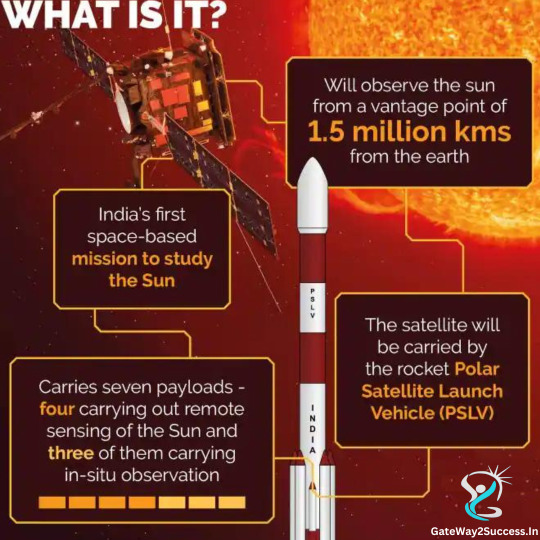
Gate Way to Success - ISRO Aditya L1 Suryayan Mission Launched
Even as Mission Chandrayaan-3 is sending some interesting information related to Moon every other day, ISRO's next mission, PSLV-C57/Aditya-L1 Mission, aimed at conducting research about Sun, is set to launch on Saturday (September 2, 2023). The 24-hour countdown of the sun mission has begun. In a tweet that Indian Space Research Organisation (ISRO) posted on Friday (September 1, 2023), it said, "The 23-hour 40-minute countdown leading to the launch at 11:50 Hrs. IST on September 2, 2023, has commended today at 12:10 Hrs."
On 02nd September, 2023 at 11:50 AM IST; ISRO successfully launched the Aditya L1 mission, marking another significant achievement after their recent Chandrayan 3 lunar expedition. The launch took place from the Satish Dhawan Space Centre on the Eastern coast, and the Polar Satellite Launch Vehicle (PSLV) had its longest flight, lasting approximately 63 minutes.
Aditya-L1 is a space-based observatory designed to study the Sun. After a 125-day journey covering about 1.5 million kilometres from Earth, the spacecraft will be positioned in a Halo orbit around Lagrangian point L1, which is the point closest to the Sun. Amongst its scientific objectives, the mission will capture images of the Sun for research purposes.
The mission's primary objectives include understanding Coronal Heating, Solar Wind Acceleration, the initiation of Coronal Mass Ejection (CME), near-earth space weather, and solar wind distribution. Aditya-L1 carries seven scientific payloads, including the Visible Emission Line Coronagraph (VELC), which will capture images of the solar corona and CME dynamics, making it the largest and most technically challenging payload on the mission. Other instruments, such as the Solar Ultraviolet Imaging Telescope, Aditya Solar Wind Particle Experiment (ASPEX), Plasma Analyser Package for Aditya (PAPA), Solar Low Energy X-ray Spectrometer, High Energy L1 Orbiting X-ray Spectrometer (HEL1OS), and Magnetometer, will provide valuable data on various aspects of the Sun's behaviour.
All of the scientific payloads on Aditya-L1 have been developed within ISRO's research centres through close collaboration, showcasing India's expertise in space research and exploration.
Go to Our to the given links to Support us- #WhatsApp- +91 8851135978, #Gmail- [email protected], #Website- Gateway2Success.In
#delhi#noida#indirapuram#india#govtjobs#mbbsadmission#gateway2success#government#rakshasa#gatewaytosuccess#rakshak#delhincr#ISRO#isroindia#isromissions#isromoonmission#chandrayaan#chandrayaan 3#chandrayaanlaunch#chandrayaan isro#moon mission#aditya l1
0 notes
Text

A few hours ago, the Indian space probe Aditya-L1 blasted off from the Satish Dhawan space center atop a PSLV-XL rocket. After about ten minutes, it regularly separated from the rocket's last stage. In about 109 days, Aditya-L1 will reach the Lagrange point called L1, about 1.5 million kilometers from the Earth, where it will begin its mission of observing the solar atmosphere and various processes taking place on the Sun's surface. It will join other space probes and solar observatories helping to unlock the last secrets of the Sun.
1 note
·
View note
Text
ISRO's Aditya-L1 Mission: Journey to Sun's Secrets!

After a successful landing on the Moon, the Indian Space Research Organisation is ready to launch its Aditya-L1 mission to study the Sun at 11.50 am on Saturday from the second launch pad at Sriharikota.The 1,480 kg spacecraft will be carried by India’s workhorse Polar Satellite Launch Vehicle (PSLV) and put in a highly elliptical orbit of 235 km x 19,500 km around the Earth. The PSLV in its XL configuration, which has six solid fuel-based boosters, will take just over an hour to place the satellite in orbit.
0 notes